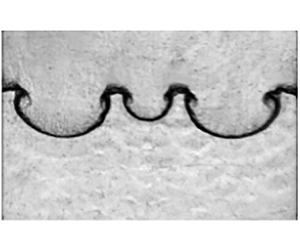Published online by Cambridge University Press: 21 September 2022

Shock-tube experiments on various two-bubble and two-spike interfaces are performed to examine the dependence of bubble competition and spike competition on the initial spectra and density ratio of the interface. The differences in the influences of bubble competition and spike competition on the Richtmyer–Meshkov instability are highlighted for the first time. The bubble-competition effect is mainly dependent on the initial spectra of the two-bubble configuration. In contrast, the spike-competition effect is determined by both the initial spectra and density ratio. The extended buoyancy–drag model is adopted to explain the variation of the drag force imposed on the long-wavelength and short-wavelength structures as the initial conditions change. Based on the spectrum analysis, it is found that the constituent modes of two-bubble and two-spike interfaces have different contributions to the long-wavelength and short-wavelength perturbation growths. A generalised, nonlinear, analytical model is then established to quantify the bubble-competition effect and spike-competition effect considering arbitrary initial spectra and density ratio. The bubble-competition effect is believed to be stronger than the spike-competition effect at a high density ratio because it suppresses the high-frequency perturbation growth more evidently.